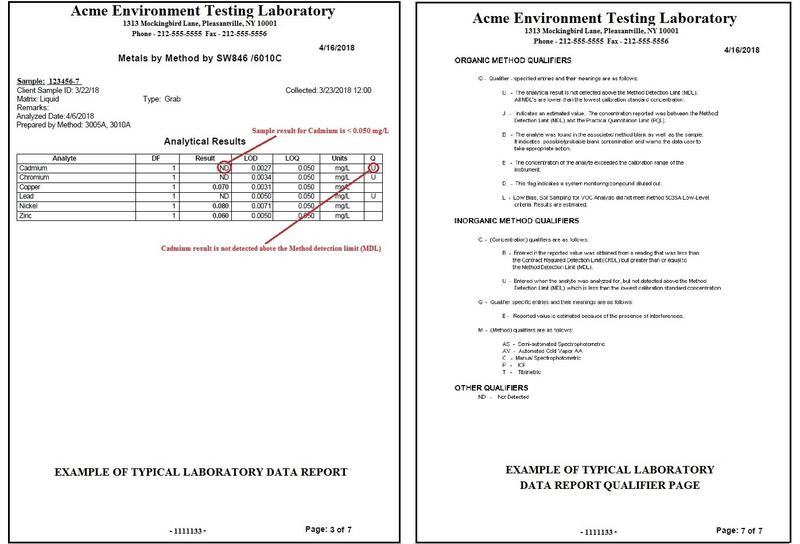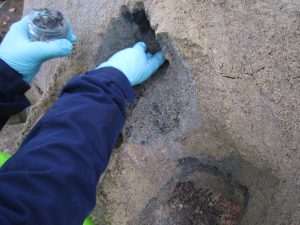Laboratory Data Should Answer Questions, Not Create Them!
In today’s complex world of ever-evolving and changing regulations, environmental testing has become common place and routine. Due to 
Current environmental laboratory data reports are required to contain a wealth of information, including case narrative, analytical results, quality controls, qualifier notations and in some instances analytical readouts and/or graphical results. Reading and interpreting the results can be confusing.
Common Terms Used Reports
A laboratory report includes the results of the Quality Assurance/Quality Control program maintained by the laboratory. These results may be confused with the sample results unless you can recognize the terms and understand their meaning.
Trip Blank: Sample container, often filled with distilled water. The trip blank travels unopened to the site with the empty sample containers and returns unopened to the laboratory with the samples. This is done in order to confirm that no contamination has been picked up during the “trip” to and from the sample location. If contamination is found in the trip blank, it means that samples may also have been contaminated.
Method Blank: An analyte free matrix which is carried through the complete preparation and analytical procedure. The Method Blank is used to evaluate contamination resulting from the complete preparation and analytical procedure.
Laboratory Control Sample (LCS): Used to evaluate the performance of the total analytical system, including all preparation and analysis steps.
Continuing Calibration Verification (CCV): A check standard used to determine if the sample analysis is within established control limits.
Internal Standard: Analyte added to all samples at a constant concentration to verify continued quality control acceptance.
Duplicate: A duplicate is a second sample collected and processed as identical as possible to the first sample. This sample is than taken through the entire analytical procedure to confirm the precision of the testing. If duplicate samples do not correspond, sample results may be inaccurate.
Matrix Spike: Occasionally something in the sample itself interferes with test results. To check for interferences, the laboratory will add a known concentration of the contaminant of interest to one of the samples being tested. If recovery of the added spike does not meet established requirements, further processing of the sample is needed.
Limit of Detection: Lowest analyte concentration likely to be reliably distinguished from a blank sample.
Limit of Quantitation: Lowest detectable concentration an analytical instrument can determine at a given confidence level.
Method Reporting Limit (MRL): Lowest concentration of the substance tested that can be reported reliably.
Data Qualifiers: Used in laboratory reports to indicate a problem or irregularity with the analytical result.
Environmental Laboratory Data Reports – What Do the Results Mean?
All environmental data reports are not created equally: some results are easily interpreted and understood, while other tests require a deeper understanding of quality control procedures, sample qualifies and methodologies.
Non-Detect Doesn’t Necessarily Mean a Clean Sample
A typical environmental data report may list the results as “ND” or not detected. It is critical to understand that this does not mean that the sample does not contain the contaminant of concern. A result of “ND” simply means that the results were less than the Method Reporting Limit for that test.
This distinction is critical to confirm that the reported results are below any regulatory limit of concern. If testing is performed to demonstrate compliance, one must ensure that the Method Reporting Limit is less than the regulatory limit of concern. If not, compliance cannot be demonstrated and resampling and/or retesting with appropriate Method Reporting Limits must be performed.
What is the Letter Next to my Sample Result?
It is also important to understand and interpret the meaning of sample qualifiers. An analytical qualifier may indicate a problem or irregularity with the analytical result. A qualifier may simply report that the sample was diluted to provide reportable results within the limit of the analytical procedure and no further action is required. It may also indicate that the reported result is below the Method Reporting Limit, thus requiring further actions.
Still Confused?
Walden’s highly trained and experienced staff of scientists are available to assist with the interpretation and evaluation of your Laboratory Data Reports. Check out our laboratory consulting services. In addition, we can assist with the development of remediation plans to meet any applicable regulatory limits.
If you have any questions or concerns, please call Walden Environmental Engineering at (516) 624-7200. We have experts on staff to help.


